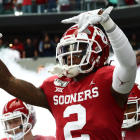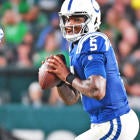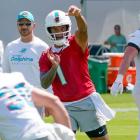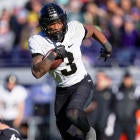Athletic testing doesn't matter for wide receivers. That's a wild claim, but it's also backed up by years of different types of research. It's about as strongly supported as something in sports can get, and yet it's too illogical to ever be accepted as a universal truth.
That doesn't mean we don't have empirical ways to analyze the position.
The first and most important is draft position. So much of NFL production is based on opportunity, and teams both draft better players higher and also give them more chances to succeed once they've invested a premium pick in them. If you're preparing for a Dynasty rookie draft or just wanting to know which rookies could be successful right out of the gate, following the NFL Draft this week and seeing how high teams are willing to pick players is the best and simplest place to start.
But that is something close to a universal truth, and we can take it a step further. The truest lesson of wide receiver prospect analysis is production begets production. Just before the Combine, I spoke with Shawn Siegele to discuss both athletic testing and which production metrics hold predictive value for future success — that piece includes links to various supporting evidence for these claims about both athletic testing and production.
But the short and sweet of it is current research suggests three key things improve a wide receiver's expected hit rate relative to their draft position:
- College production at a young age
- College production controlled for team passing volume
- Whether the player declared for the Draft early or exhausted his full eligibility
Let's look at how the 2020 class measures up in those regards. I've included our CBS Sports overall prospect ranks to estimate draft capital, a note on whether the player was an early declare, and a quick verdict on the strength of each receiver's age-adjusted production profile. I've also discussed any mitigating factors like team strength and quarterback play where applicable.
The Big Names
There has seemed to be a consensus top three at the position throughout the pre-Draft process, but a fourth name has recently separated from the group below.
CeeDee Lamb
Expected Draft round: 1 (CBS overall rank: 10)
Age-adjusted production profile: Strong
Early declare? Yes
Teammate strength is one of the biggest factors to consider at the top of the class. Lamb broke 800 receiving yards as a freshman alongside future Ravens Mark Andrews and Marquise Brown, then accounted for 26% of Oklahoma's passing yardage as a sophomore while Brown was still there. After Andrews and Brown had moved on to the NFL, Lamb (perhaps predictably) exploded in 2019, posting a 34% share of the passing yardage and 44% share of the passing touchdowns. His resume is extremely strong.
Jerry Jeudy
Expected Draft round: 1 (CBS overall rank: 12)
Age-adjusted production profile: Solid
Early declare? Yes
The next two receivers played together at Alabama — and alongside a potential future high pick in Devonta Smith — and that is frequently cited to explain their relative lack of production. Jeudy's production was solid but his share of the receiving yardage went from 27% as a sophomore back down to 26% in his junior year.
One piece of context — in Alabama's 11-2 season in 2019, the Tide won all 11 games by at least 19 points, and their average margin of victory in those games was 34.5. Alabama dominated its wins so thoroughly, we got a memorable moment where Jeudy and Smith played rock-paper-scissors on the field, presumably to determine who would run the higher-profile route.
Henry Ruggs
Expected Draft round: 1 (CBS overall rank: 15)
Age-adjusted production profile: Weak
Early declare? Yes
Whereas Jeudy's receiving yardage shares above 25% offer some hope if giving weight to team context, it's a little harder to explain Ruggs' numbers. Ruggs never accounted for more than 20% of Alabama's receiving yardage in any season, topping out at 18% this past season. His vertical skill set will play in any offense, and he was an early declare who will have strong draft capital — perhaps as strong as being the first receiver off the board — but there's legitimate reason to question whether he will ever hit a statistical ceiling at the next level or instead be more valuable to his NFL team schematically than to Fantasy rosters.
Justin Jefferson
Expected Draft round: 1 (CBS overall rank: 27)
Age-adjusted production profile: Solid
Early declare? Yes
Jefferson's 874-yard sophomore year actually accounted for a higher percentage of LSU's passing offense (29%) that year than his 1,540-yard final season (26%), as the Tigers threw for more than twice as many yards in 2019 than in 2018. Jefferson played more on the outside as a sophomore and was primarily a slot last year, showing he can produce in versatile ways.
Where the class gets deep
The next five wide receivers in the 2020 class could contend to be among the best pros of the group overall.
Brandon Aiyuk
Expected Draft round: 1-2 (CBS overall rank: 32)
Age-adjusted production profile: Solid to Strong, depending how much of a discount you apply to junior college numbers
Early declare? No
Our first non-early declare, Aiyuk excelled for two seasons at Sierra College, posting 2,499 all-purpose yards and 21 touchdowns, before transferring to Arizona State. Aiyuk's production included kick and punt returns, something that continued at ASU and has historically been a positive note on a wide receiver's profile. After a ho-hum first season at ASU (20% share of receiving yards) alongside N'Keal Harry, Aiyuk excelled this past year, accounting for 39% of the passing offense.
Tee Higgins
Expected Draft round: 1-2 (CBS overall rank: 35)
Age-adjusted production profile: Solid
Early declare? Yes
Higgins got on the field as a true freshman at Clemson, where he also had plenty of competition for reps. He accounted for 22% of the team's receiving yardage as a sophomore and 27% as a junior, so his numbers steadily improved though they didn't reach the rough 30% threshold we're typically hoping to see. He did account for more than 30% of Clemson's receiving touchdowns both of those seasons, scoring a dozen as a sophomore and pushing it to 13 last year.
Laviska Shenault
Expected Draft round: 1-2 (CBS overall rank: 37)
Age-adjusted production profile: Strong
Early declare? Yes
Shenault dealt with injury issues that were also the story of his Combine, but he was extremely productive when healthy as a sophomore at Colorado. In nine games, Shenault accounted for a ridiculous 46% of the Buffaloes' receiving yardage, and he also chipped in five rushing touchdowns as Colorado utilized his versatility to get him more touches. He added two more rushing scores in his junior year, but his receiving share fell to 30% as he spent more time on the outside in an offense that failed to throw for even 3,000 yards. Shenault's situation wasn't always ideal, but his career numbers show he has more receiving chops than those who won't look past his running back body type give him credit for.
Denzel Mims
Expected Draft round: 1-2 (CBS overall rank: 40)
Age-adjusted production profile: Solid
Early declare? No
Mims didn't declare early after a somewhat disappointing junior season, but that came on the heels of a sophomore campaign where he put up 31% of Baylor's receiving yardage and caught 35% of the passing touchdowns, qualifying as an early breakout against even the most stringent guidelines (breakout ages can vary based on varying benchmarks). Mims' Dominator Rating — the average percentage of a player's share of receiving yards and touchdowns — was at or above 30% for each of his final three seasons, but I tend to value the yardage side of that equation more, and his 23% yardage share in his junior year is the biggest question mark in his profile.
Jalen Reagor
Expected Draft round: 1-2 (CBS overall rank: 41)
Age-adjusted production profile: Strong
Early declare? Yes
One of the youngest prospects in the Draft, Reagor put up 18% of TCU's receiving yardage and 29% of their touchdowns as a freshman and then had a huge sophomore campaign with 37% yards and 47% touchdowns. His junior season looks poor by comparison, but quarterback play has been cited extensively, and his 29% Dominator Rating isn't terrible. It's much easier to look past that when you realize he contributed rushing and both punt and kick return stats in his career.
Mid-round names
Because the top of the class is so deep, these prospects with a little less shine could wind up being great value options.
Michael Pittman Jr.
Expected Draft round: 2-3 (CBS overall rank: 58)
Age-adjusted production profile: Solid
Early declare? No
Through his first two seasons, Pittman hadn't produced much, then he put together a solid junior year in a subpar passing offense where he accounted for 29% of the team's passing yardage and 40% of the passing scores in his 10 games. He mostly backed that up last year in a better overall offense, posting an impressive 100-catch season — but as a 22-year-old senior, an age where many prospects will be playing in the NFL.
KJ Hamler
Expected Draft round: 2-3 (CBS overall rank: 68)
Age-adjusted production profile: Solid
Early declare? Yes
Hamler redshirted his first year while rehabbing an ACL tear, so he only played two seasons at Penn State. But in each season, the undersized slot receiver was reasonably productive, going from 26% of the Nittany Lions receiving yards and 24% of their touchdowns in 2018 to 31% and 32% in 2019. Hamler's a young prospect who also adds considerable rushing and return production.
Chase Claypool
Expected Draft round: 2-3 (CBS overall rank: 74)
Age-adjusted production profile: Weak
Early declare? No
Claypool is a size/speed freak, but he didn't translate that athleticism into much production at Notre Dame until his senior season. There's some pure athletic upside here that looks better after his impressive final season, but Claypool topped out at a 21% share of his team's receiving yardage as a sophomore before his 32% senior season, and he only scored six touchdowns in his first three seasons before posting an impressive 13 last year. The late breakout doesn't doom him, but it is something to be wary of.
Tyler Johnson
Expected Draft round: 3-5 (CBS overall rank: 81)
Age-adjusted production profile: Strong
Early declare? No
Johnson stayed all four years at Minnesota, but in each of his sophomore, junior and senior seasons, he posted at least 40% of his team's receiving yardage and touchdowns in games played. Purely as a producer, his resume is among the strongest in the class, including one of the earliest and most dominant team-adjusted breakouts. It's hard to reconcile that with him staying all four years and his expected later-round status, but those factors can't be ignored.
Donovan Peoples-Jones
Expected Draft round: 3-5 (CBS overall rank: 92)
Age-adjusted production profile: Weak
Early declare? Yes
Peoples-Jones never accounted for more than 21% of Michigan's receiving yardage in any of his three seasons, and while his athletic measureables are enticing and he added some punt return production, he looks likely to be overdrafted by a team that thinks it can teach him the nuances of the position.
Devin Duvernay
Expected Draft round: 3-5 (CBS overall rank: 95)
Age-adjusted production profile: Weak
Early declare? No
Duvernay ran a 4.39 40, and while his athleticism is different than that of Chase Claypool, his production profile is similar. Like Claypool, Duvernay stayed for his senior season and posted his first remotely productive year. Like Claypool, that senior year was a dramatic step up — Duvernay accounted for 37% of Texas' receiving yardage after previously topping out at 16%.
A YAC specialist slot guy with underdeveloped receiving skills, Duvernay has a shot to make some plays if he winds up earning NFL reps, but he's not particularly likely to be a consistent Fantasy producer given how long it took him to produce in college.
Antonio Gandy-Golden
Expected Draft round: 3-5 (CBS overall rank: 99)
Age-adjusted production profile: Strong
Early declare? No
Gandy-Golden starred at Liberty, which made the jump to BCS Independent before his junior season. Team-adjusted stats from his first two seasons are harder to come by, but Gandy-Golden posted at least 1,000 receiving yards and 10 touchdowns in three straight seasons to close his career. He accounted for more than 35% of Liberty's receiving yardage in each of his junior and senior seasons, and it's safe to say that was likely the case as a sophomore as well. Of course, competition level is a concern on top of his staying all four years and being projected as a later-round pick.
Bryan Edwards
Expected Draft round: 3-5 (CBS overall rank: 101)
Age-adjusted production profile: Strong
Early declare? No
Edwards burst onto the scene with 23% receiving yardage and 33% touchdown shares as a freshman in the SEC, then backed that up with 28% of each in his sophomore year. He had a down junior year at 24% and 22% before posting his best numbers as a senior, going for 35% of the passing yardage and 50% of the scores in his 10 games. The junior year is a minor red flag, but he was competing with Deebo Samuel for looks and was previously very good right out of the gate in the SEC. He finished with a strong enough senior season to boost his profile overall, but is another non-early declare for whom draft capital will be telling.
Van Jefferson
Expected Draft round: 3-5 (CBS overall rank: 102)
Age-adjusted production profile: Weak
Early declare? No
Jefferson has been rising up some boards, and there's something to be said about him transferring mid-career and the struggles around that. But even after redshirting at Ole Miss — where he then played for two years before playing his final two at Florida — Jefferson topped out at a 20% share of yards in four college seasons, which he achieved in his redshirt junior season at Florida before that number fell to 18% last year. Simply put, it's hard to see an NFL future for a 23-year-old redshirt senior posting those numbers.
Sleepers to watch
There are several underrated, productive options further down draft boards. Here are five with good profiles.
Gabriel Davis
Expected Draft round: 3-6 (CBS overall rank: 119)
Age-adjusted production profile: Solid to Strong
Early declare? Yes
Some reports have Davis going as high as the second round, and if he does, it will be wheels up. While at UCF, Davis got on the field and produced an 11% Dominator Rating as a freshman, then went for 25% of the yards and touchdowns in his sophomore campaign. That meant he didn't break out until he was a junior, but he went over 30% in both metrics last year before declaring early. It's not quite an elite profile, but it's very good.
Isaiah Hodgins
Expected Draft round: 3-6 (CBS overall rank: 129)
Age-adjusted production profile: Strong
Early declare? Yes
Hodgins posted a 15% Dominator Rating as a freshman in the Pac-12, then went for 31% yards and 29% touchdowns as a sophomore and 38% yards and 43% touchdowns as a junior. Those final two seasons before declaring early give him a fantastic overall profile, but he looks likely to be a Day 3 pick so he might never get a shot at the next level.
Lynn Bowden
Expected Draft round: 3-6 (CBS overall rank: 144)
Age-adjusted production profile: Solid to Strong
Early declare? Yes
Bowden played quarterback in high school, and he took over as Kentucky's quarterback midseason last year due to injuries. Prior to that, he posted 36% yardage and 38% touchdown shares as a sophomore slot receiver, and was reasonably productive early in 2019 before the position switch. After the switch, he threw just 74 passes but rushed 185 times for 1468 yards and 13 scores on the ground. That sophomore breakout year indicates plenty of upside as a receiver, and versatility is always a plus.
Quez Watkins
Expected Draft round: 4-7 (CBS overall rank: 169)
Age-adjusted production profile: Strong
Early declare? Yes
Watkins is another early declare who posted yardage shares of 34% and 36% in his final two seasons at Southern Miss. Watkins' 4.35 40-yard dash time at the Combine is especially notable because he translated that speed into production in college, and if it means a team grabs him higher than anticipated there's plenty of upside here.
Quintez Cephus
Expected Draft round: 4-7 (CBS overall rank: 187)
Age-adjusted production profile: Solid to Strong
Early declare? Yes
Cephus didn't do much as a freshman, but posted a 29% share of yards and 43% touchdowns in his nine games as a sophomore. He got up to 32% yards and 39% touchdowns in 2019, for back to back 35% Dominator Ratings to close his career.





















